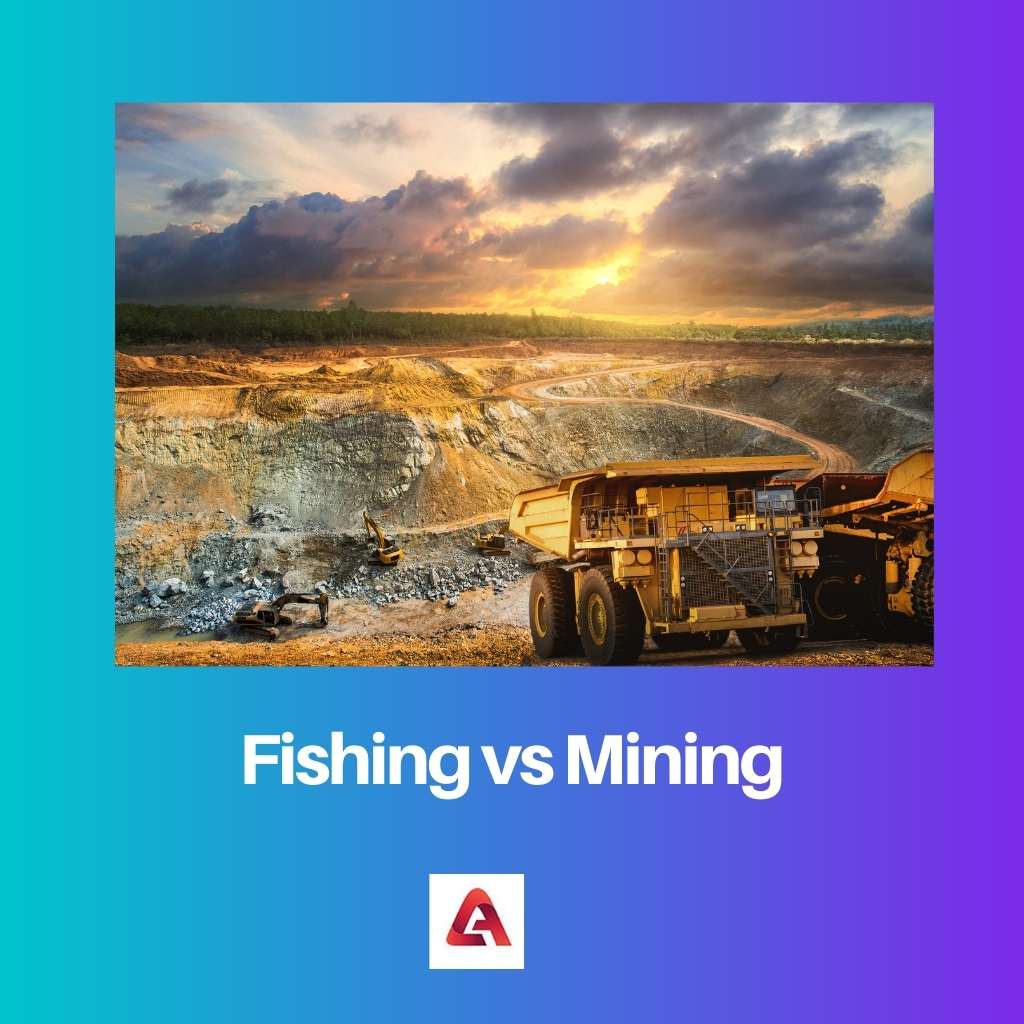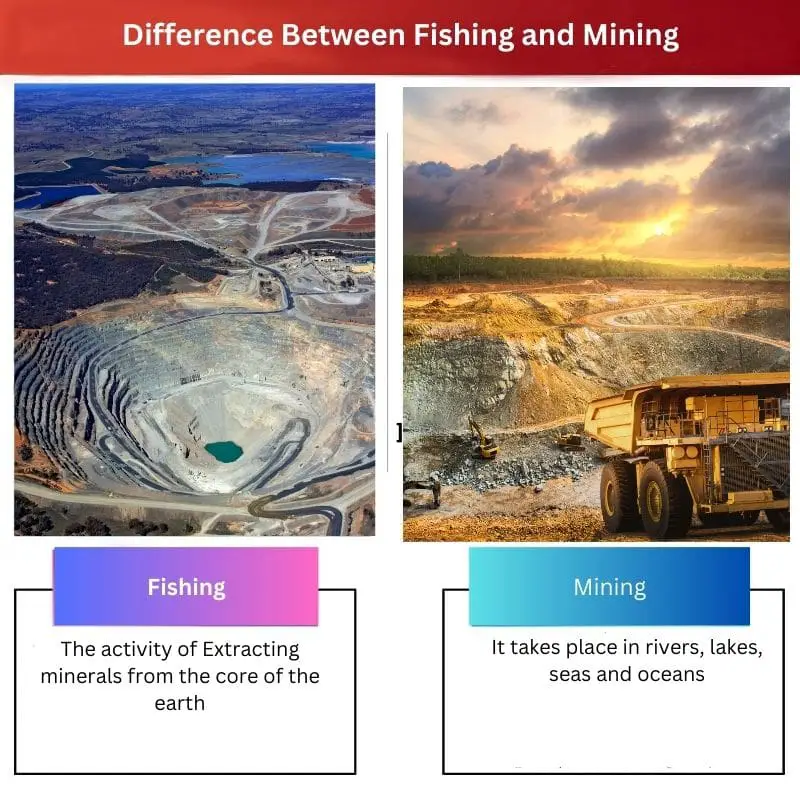The primary sector’s concern is the extraction of natural resources or raw materials from the earth. The economic osector’ss of a primary sector are influenced by the nature of the location.
Economic activities are human actions that contribute to the creation of income. These activities are divided into primary, secondary, and tertiary.
This industry uses earth’s resources (land, plants,earth’sand minerals). As a result, it includes activities like hunting, forestry, agriculture, fishing, and mining.
These activities provide raw resources and staple foods such as coal, wood, iron, and corn.
Key Takeaways
- Fishing involves the extraction of aquatic organisms for consumption or other purposes, while mining extracts minerals and resources from the earth.
- Fishing requires specialized equipment like nets, lines, and hooks, while mining uses heavy machinery and explosives.
- Fishing is a renewable resource, while mining involves the depletion of non-renewable resources.
Fishing vs Mining
Fishing and mining are two economic activities that involve catching fish and other aquatic animals for food or commercial purposes. Mining is extracting valuable minerals, metals, or other geological materials from the earth using various methods.

Fishing is among the most important primary industries in the world. It comprises a variety of tasks, including shipping, selling, conserving, marketing, and processing fish products.
Industrial fish farming is growing the fastest in the world’s food production system, supplying over half of the world’s seafood.
Mining refers world’sextraction of raw materials from the earth, such as rocks and metals, minerals, and gemstones. Mining also includes non-renewable resources such as natural gas and petroleum.
The modern mining process entails calculating the potential value of a mining enterprise, identifying ore resources, and extracting precious metals.
The secondary industry likewise relies heavily on mining for raw materials to manufacture and create a diverse range of vital products.
Comparison Table
| Parameters | Fishing | Mining |
|---|---|---|
| Meaning | The activity of Extracting minerals from the core of the earth | It takes place in rivers, lakes, seas and oceans |
| Where it takes place | It takes place in crust of the earth | Availability of fish depends on the nature of coastline, cool climate, cold and warm ocean water currents etc |
| Usage | Used as a food | Used as industrial raw material |
| Distribution | Found everywhere in water bodies | Highly uneven distribution |
| Availability depends on | Availability of minerals depends on the geological structure | Availability of minerals depends on the geological structure. |
What is Fishing?
The activity of catching a fish is known as fishing. Fish are commonly captured in the wild and captured in bodiesthey’reer that have been stocked.
Hand collection, spearing, netting, angling, and trapping are all methods of catching fish. Fishing” also refers to the ca“ture of aquatic organisms other than fish.Hand collection, spearing, netting, angling, and trapping are all methods of catching fish. “Fishing” also refers to capturing aquatic organisms other than fish.
Although this term is not commonly used to denote the capture of farmed fish or sea mammals like whales, the phrase whaling is more appropriate.
Fishing is done for recreational as well as commercial purposes.
The fishing industry deals with catching cultivating, processing, storing, transporting, advertising, or trading fish or its products.
The objective behind commercial fishing is to satisfy the demand for fish and seafood for human consumption and its use in various industrial processes as raw material.
Fisheries not only provide a source of food and employment for communities like fishing villages but a feeling of collective cultural identity.
Particular places are considered fishing hotspots, where anglers go on holiday or compete. Visitors’ economic impact on fisVisitors’be a substantial if not primary, contributor to tourism earnings for some destinations.
Fishing even had an influence on various religions like Hinduism, and Christianity, as well as a variety of new-age religions.
An ever-increasing demand of the global population for fish as a food source has resulted in over-exploitation of already depleted fisheries.
Empty oceans indicate empty stomachs – and, as a result, empty purses for all who depend on fishing for a living. As a result, a more sustainable method for fishing is urgently needed.

What Is Mining?
The extraction of precious minerals and other geologic elements from the Earth, from an ore body, vein, lode, reef, seam, or placer deposit, is known as mining.
Often, those materials that cannot be cultivated through agricultural methods or generated mechanically in a laboratory or industry must be obtained through mining.
In a broader sense, mining means extracting non-renewable resources (like petroleum or natural gas).
Exploring for ore bodies, analyzing the economic potential of a mine, collecting the needed materials, and finally, restoration of the land when the mine is closed are all part of modern mining processes.
The financial viability of investing in the technology, personnel, and energy needed to extract, purify, and transfer the materials found at the mine by manufacturers who can utilize the material determines the economic viability of exploitation of these resources for raw material.
Metals, dimension stones, coal, gemstones, limestone, chalk, rock salt, gravel, and clay are among the ores extracted by mining.
Mining is quite harmful to the environment. It is a driver of deforestation. Trees and vegetation are cut and burned to mine.
Large-scale mining projects employ massive bulldozers and excavators to collect metals and minerals from the soil when the earth is entirely bare.
They use chemicals such as cyanide or mercury to combine the extracts. These chemicals are commonly dumped into streams, rivers, bays, and oceans after passing through pipes.
This contamination pollutes all living organisms in the body of water, ultimately affecting the people dependent on fish for the primary source of protein and economic survival.

Main Differences Between Fishing and Mining
- Fishing means catching or collecting fish, and Mining is an activity in which various kinds of minerals are extracted from the earth.
- Fishing occurs in natural water bodies such as lakes, rivers, and oceans. On the other hand, mining occurs in the Earth’s crust.
- Fishes and other aquatic animals derived from fishing are used as food. While the extracted minerals and materials from mining are used as raw materials by various industries and are processed by them to reach the final consumers.
- Fishes can be found everywhere in water bodies, but for mining, the distribution is highly uneven as minerals can’t be found everywhere insidecan’th’s crust. Minerals are onlyearth’sat some particular places.
- The suitability of a place for fishing depends on the availability of fish, which consequently depends on various factors such as the nature of coastline, cool climate, cold and warm ocean water currents etc. And the availability of minerals depends on the geological structure of a place.

- https://www.tandfonline.com/doi/abs/10.2989/1814232X.2012.749595
- https://www.sciencedirect.com/science/article/pii/S0016718521000208

This is a terrible comparison, the two activities are completely unrelated.
I think it emphasized the importance of both fisheries and mining in a way that is very clear.
The article aptly gives a detailed comparison of Fishing and Mining.
This is a great look at the primary differenct between these sectors, very informative.
I’m not entirely sure why you’re comparing these two sectors, they are entirely different.
I have to say, I don’t believe I ever realized the environmental cost in mining, and the article is quite enlightening.